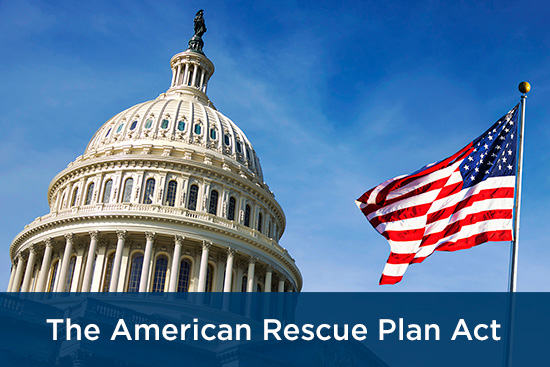What to Expect from the Latest Coronavirus Relief Package
By Jesse Giordano, CFP® | March 9, 2021Big news came over the weekend regarding the latest $1.9 trillion coronavirus relief bill. The American Rescue Plan Act of 2021 was passed by the Senate on Saturday, leaving the House to give it a final vote before it heads to President Biden’s desk and is signed into law.

These changes come at a time when the U.S. economy looks much different than it did 11 months ago. Instead of closing down, more and more businesses are reopening. People are getting back to work, and the unemployment rate has fallen to 6.2%—down from 15% when the CARES Act passed. On the pandemic front, there are more Americans who’ve now received their second Covid-19 vaccination than there are confirmed Covid cases in the U.S. since the pandemic began, which is certainly encouraging.
Because of the sheer size of the American Rescue Plan Act, we can expect it to accelerate the economy in the short term. We may end up seeing significant GDP growth for the first half of 2021. At the same time, it also raises the prospects of inflation down the road, which may decrease the value of the dollar.
It’s also worth noting that the latest relief bill amounts to more fiscal stimulus than the CARES Act and the second relief package that passed at the end of 2020. Given last year’s rebound from less stimulus, recession concerns shouldn’t be top of mind right now.
We’ve sifted through the details and, most importantly, how they could affect your financial life. Here’s what you can expect if the massive new relief package gets the final stamp of approval.
More Direct Payments to Go Out This Month
The package includes the largest relief payments yet; $1,400 per person, including each dependent child. To qualify for the full payment, individuals can’t earn more than $75,000. The income cap jumps to $150,000 for married joint filers. Payment amounts phase out entirely for individuals earning $80,000; $160,000 for married couples filing jointly. President Biden says that direct payments could begin going out this month.
Increased Unemployment Benefits Would Be on the Way
With unemployment aid programs set to expire in mid-March, the new relief package includes an extra $300 per week in jobless benefits that will carry through September 6. That’s on top of regular unemployment benefits. The first $10,200 of these benefits would also be considered nontaxable for folks who earn $150,000 or less. Another resource for jobless Americans is that the relief package would also subsidize COBRA insurance coverage.
The Child Tax Credit Would be Expanded for One Year
The relief package would expand the child tax credit in a number of ways. For many families, it would increase the credit from $2,000 per child to $3,000. If you have a child under 6, that amount would bump up to $3,600. The legislation would do away with the earnings floor, as well. (Ordinarily, you need to earn at least $2,500 to qualify for the credit.) What’s more, the credit would now be fully refundable—and 50% could begin going out in the second half of 2021. These are huge wins for parents, particularly those in low-income households.
More Help for Small Businesses
The Paycheck Protection Program (PPP), which provides forgivable loans to help small business owners cover day-to-day costs and payroll, would get infused with another $7.25 billion. $25 billion would also be set aside for bars and restaurants that have suffered due to Covid-19. This money could be used to pay for things like rent, payroll and more. Aid would come by way of $10 million grants per company and caps at $5 million for each brick-and-mortar location.
The Affordable Care Act Would be Significantly Expanded
The new bill would increase the subsidies to pay for health insurance through the Affordable Care Act until the end of 2022. If it goes through, experts predict a 10% spike in participation due to more affordable premiums and looser qualifying criteria for middle-class families. The relief package would also promote and incentivize the expansion of Medicaid. On the topic of health care, roughly $14 billion would be reserved for Covid-19 vaccine distribution.
Student Loan Forgiveness Would be Tax-Free
When the government cancels student loan debt, the amount that’s forgiven is generally treated as taxable income. The American Rescue Plan Act includes a provision that would make loan forgiveness a tax-free experience for borrowers, potentially saving them thousands. It would be set to last through 2025.
Hundreds of Billions of Dollars Earmarked for State Aid
State and local governments would be in for relief to the tune of $350 billion. This is the amount the new coronavirus relief package would send to state and local governments to help offset the costs they incur through 2024.
The latest Covid-19 relief package is a complicated stimulus bill that has many moving parts. At Opal Wealth Advisors, we’re here to help you make sense of it all and better understand how it might impact your financial life. Contact us todayto set up a one-on-one consultation at no cost to you.
Be a Smart Investor
Stay up-to-date with industry-leading information and news delivered straight to your inbox.
Get our timely insights delivered to your inbox (Blog)
Please remember that past performance may not be indicative of future results. Different types of investments involve varying degrees of risk, and there can be no assurance that the future performance of any specific investment, investment strategy, or product (including the investments and/or investment strategies recommended or undertaken by Opal Wealth Advisors, LLC [“OWA]), or any non-investment related content, made reference to directly or indirectly in this commentary will be profitable, equal any corresponding indicated historical performance level(s), be suitable for your portfolio or individual situation, or prove successful. Due to various factors, including changing market conditions and/or applicable laws, the content may no longer be reflective of current opinions or positions. Moreover, you should not assume that any discussion or information contained in this commentary serves as the receipt of, or as a substitute for, personalized investment advice from OWA. OWA is neither a law firm, nor a certified public accounting firm, and no portion of the commentary content should be construed as legal or accounting advice. A copy of the OWA’s current written disclosure Brochure discussing our advisory services and fees continues to remain available upon request or at www.opalwealthadvisors.com. Please Remember: If you are a OWA client, please contact OWA, in writing, if there are any changes in your personal/financial situation or investment objectives for the purpose of reviewing/evaluating/revising our previous recommendations and/or services, or if you would like to impose, add, or to modify any reasonable restrictions to our investment advisory services. Unless, and until, you notify us, in writing, to the contrary, we shall continue to provide services as we do currently. Please Also Remember to advise us if you have not been receiving account statements (at least quarterly) from the account custodian.



